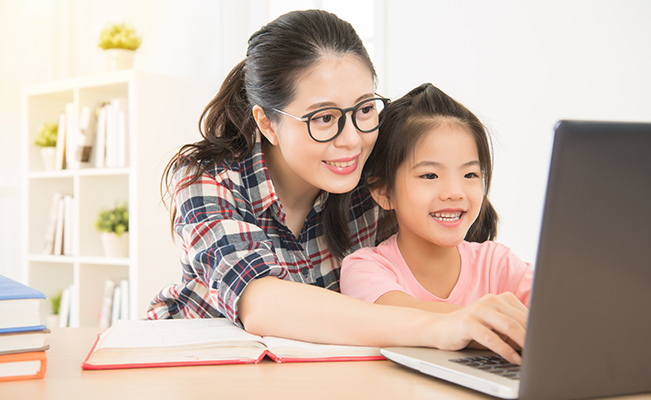
With the current global pandemic, parents face an important decision on how to send their children back to school this year. Schools everywhere have been adjusting to this new normal, figuring out how to address the needs of their students in going to school .
Traditionally, going to school involves a face-to-face approach to education where lessons are taught by teachers in a classroom setting. Since the pandemic makes this too risky to consider, alternative approaches to school have been offered by educational institutions while some parents have chosen to homeschool. Either way, until it is safe again to return to institutions of learning, school will have to move into the comfort of our homes - bringing new meaning to going back to school .
Back to School Basics: Different Modes of Learning
Learning must go on for our children even if they are not physically going to school , and there are different modes of distance learning offered in the Philippines to address this need. Which “back to school” modes best suits your household will depend on your specific needs and goals. While parents have always been encouraged to take an active part in their children’s education, learning now becomes something that requires parents to be more proactive than ever.
- Homeschooling –Through this set-up, parents become educators with the freedom to create their own curriculum - making the experience of going back to school all the more fun . They can choose to implement lesson plans sent by accredited institutions or they can make their own1. Homeschool providers are there to give varying levels of guidance, but parents take on the role of teacher, principal, gym instructor, guidance counselor and more. Homeschooling requires the most involvement from parents as topics, modules, and teaching methods are all upon their discretion - all of which are very different from physically going to school.
- Online Learning – This mode of learning focuses on delivering the majority of the course content online2. The classroom dynamic is replicated as there is a teacher giving lessons to students who attend the class via video call. This method does not involve parents as much, but it requires a reasonably capable computer or tablet with a reliable internet connection until students are able to go back to school. Online Learning also explores a very limited approach and may not be suitable for young children who need constant stimulation and guidance which they can get by physically going to school .
- Modular Distance Learning – With this mode of learning, Self-Learning Modules are provided via print or digital format and are sent to students for them to accomplish at home. This is supplemented by lessons transmitted via government-run radio and television stations3. Consultations with teachers are scheduled as needed in order to check the progress of each student until it is possible for them to come back to school. This is the ideal approach for children in households with limited resources4. As with all the teaching methods discussed here, Modular Distance Learning requires participation and guidance from parents. In particular, they are in charge of implementing the modules received from the school.
- Blended Learning – Also known as Hybrid Learning, this is a mix of both online and offline methods. It is a combination of Online Learning and Modular Distance Learning5. This approach addresses the problem of households that have no internet access by providing alternatives to online resources, providing printed supplementary materials and textbooks which students would normally get by going to school . However, implementation will still need to be guided by parents as teachers are not available to do this until students can go back to school.
Going Back to School: Approach for Young Children
In planning a “going back to school” regime at home, parents need to take into consideration how learning works for young children ages three and up. During the child’s formative years, neural circuits are rapidly formed through their experiences. Aside from adequate nutrients, which can be supplemented by products like Enfagrow A+ Four, a stimulating learning environment is needed to enhance brain development.
It is important to have a multidimensional environment which has the capacity to address the different aspects of a young child’s development: physical, social, emotional, and mental6 - especially when they’re not physically going to school. This creates the foundation by which interest in future learning is based on. Exposure to various settings is how children are programmed to learn in their succeeding years7 as part of going back to school in the new normal.
Since a teacher will not be present to guide the implementation of lessons, it is important for parents to step up and fill the gap until their young ones are able to go back to school. After all, it is every parent and teacher’s goal to help the children under their care to become their best selves8. Involvement will also help create a stable relationship between parent and child, which provides a secure environment for other aspects of development in their lives.
It is key for parents to find a method that will take into consideration a varied approach which caters to a child’s inquisitiveness and cognitive capacity9. There needs to be a balance between school and play which parents can address in a myriad of ways, from engaging them in day-to-day activities to providing engaging methods that mimic play.
Ideally, when students go back to school after the pandemic is over, parents will be able to increase engagement in their children’s learning process using this experience. Parents playing a role in education will create a more balanced, holistic approach to child development.
Join other like-minded moms at Enfagrow A+ Four’s Momspirations page to discover awesome online tools such as Homeschooling Hub, Milestone Monitor, and Enfa Healthy and Smart Recipes that can help raise healthy, smart kids with a heart!
References:
1 What is Homeschooling and How Does it Work? (2020). Retrieved August 31, 2020 from https://hslda.org/post/what-is-homeschooling
2 Blended and Distance Learning (2012). Retrieved August 31, 2020 from https://www.niu.edu/citl/resources/guides/instructional-guide/blended-a…
3 Academe in the New Normal (2020). Retrieved August 31, 2020 from https://dailyguardian.com.ph/academe-in-the-new-normal/
4 Challenges Parents Face in Education’s New Normal (2020). Retrieved August 31, 2020 from https://www.manilatimes.net/2020/08/09/business/sunday-business-i-t/cha…
5 Blended Learning is the New Normal in Philippine Education (2020). Retrieved August 31, 2020 from https://www.manilatimes.net/2020/07/24/supplements/blended-learning-is-…
6 The Formative Years: UNICEF’s Work on Measuring Early Childhood Development (n.d.). Retrieved August 31, 2020 from https://www.unicef.org/earlychildhood/files/Brochure_-_The_Formative_Ye…
7 The Benefits of Hands-On Learning for Children (n.d.). Retrieved August 31, 2020 from https://appletreekindergarten.com/blog/benefits-hands-learning-children/
8 Parent Involvement has Always Mattered. Will the COVID-19 Pandemic Finally Make this the New Normal in K-12 Education? (2020). Retrieved August 31, 2020 from https://www.forbes.com/sites/colinseale/2020/05/19/parent-involvement-h…
9 Academic Learning in 3-5 Year Olds (n.d.). Retrieved August 31, 2020 from https://www.scholastic.com/parents/family-life/creativity-and-critical-…

